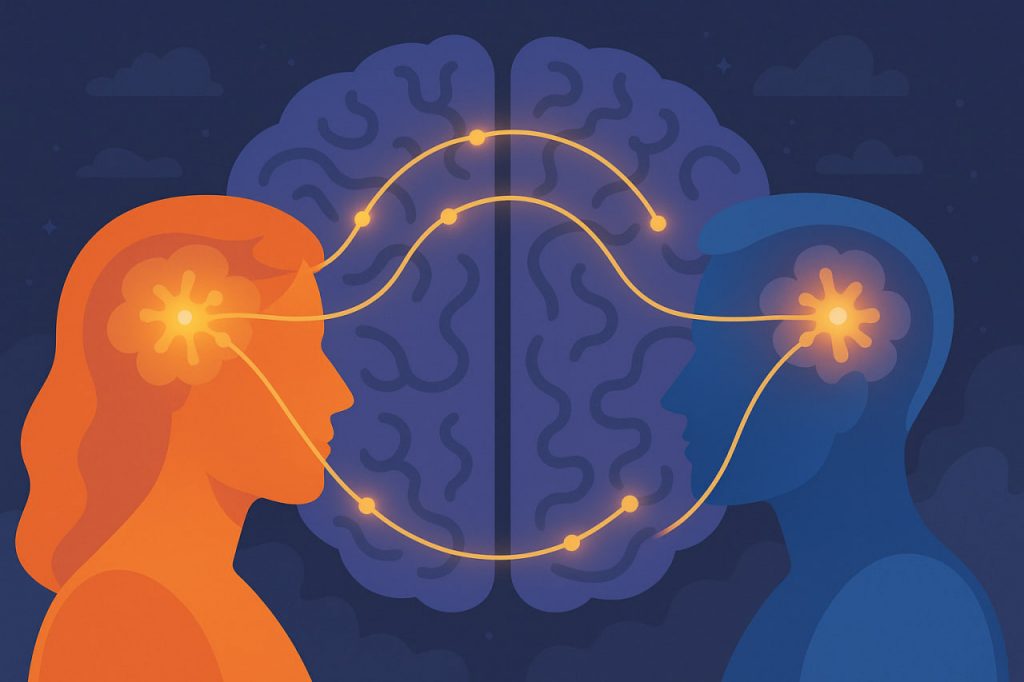Human beings are social by nature. We smile when others smile, feel pain when someone gets hurt, and understand others’ intentions even before they speak. Behind this remarkable ability lies one of the most fascinating discoveries in modern neuroscience — mirror neurons. These special brain cells allow us to “mirror” the actions and emotions of others, forming the foundation of empathy, learning, and social connection.
The Discovery of Mirror Neurons
Mirror neurons were first discovered in the early 1990s by a team of Italian neuroscientists led by Giacomo Rizzolatti at the University of Parma. While studying the brains of macaque monkeys, the researchers noticed something extraordinary: certain neurons in the premotor cortex fired not only when the monkeys performed an action — such as grasping an object — but also when they watched another monkey or a human perform the same action.
This meant the brain was simulating the action internally, as if performing it itself. The scientists called these cells mirror neurons, because they “reflected” observed behavior. Later research confirmed similar systems in the human brain, particularly in the inferior frontal gyrus and parietal lobes.
How Mirror Neurons Work
Mirror neurons activate when we see, hear, or even imagine an action or emotion. For example, watching someone yawn can make us yawn too; seeing a person smile triggers subtle muscle activity in our own face. This process allows the brain to model others’ behavior internally, providing instant understanding of their intentions and emotions.
Scientists believe that mirror neurons create a bridge between perception and action, allowing us to understand others not through logic, but through direct neural resonance — we literally “feel” what they feel.
The Role of Mirror Neurons in Human Life
1. Empathy and Emotional Connection
Mirror neurons are essential for empathy — the ability to share and understand another’s emotional state. When we see someone suffering or happy, our mirror system partially reproduces that emotional experience in our own brain, helping us respond compassionately.
2. Learning and Imitation
From infancy, humans learn by observing and imitating. A baby smiles when it sees a parent smile, copies gestures, or learns language through repetition. Mirror neurons make this observational learning possible, allowing the brain to translate visual input into motor understanding.
3. Communication and Social Interaction
Understanding facial expressions, body language, and tone of voice depends heavily on mirror neuron activity. This system enables us to predict others’ reactions, synchronize emotions, and build trust.
4. Art, Music, and Sports
Watching a dancer or an athlete can evoke physical sensations in observers because the brain’s motor regions simulate the movement. Similarly, emotional reactions to art or music may involve mirror activity, as we “feel” the artist’s intent through neural resonance.
Mirror Neurons and Autism
Some researchers have suggested that dysfunction in the mirror neuron system may contribute to autism spectrum disorder (ASD). Individuals with ASD often have difficulties with imitation, empathy, and reading emotional cues. However, this hypothesis remains debated — while mirror neuron differences are observed, autism is a complex condition with many contributing factors.
Mirror Neurons and Modern Society
Understanding mirror neurons has profound implications beyond neuroscience. It explains why social media can spread emotions so quickly — happiness, fear, or anger are contagious because our brains automatically synchronize with what we observe.
It also shows why kindness and compassion have ripple effects: when we act positively, others’ mirror neurons reflect that positivity, inspiring similar behavior in return. This neural empathy may be one of humanity’s greatest tools for cooperation and peace.
The Future of Mirror Neuron Research
Scientists continue exploring how mirror systems interact with language, morality, and consciousness. Some theories suggest that mirror neurons were the evolutionary key to human culture, enabling the transmission of knowledge and art. As neuroscience advances, understanding this system may help design better therapies for trauma, social disorders, and emotional intelligence training.
Interesting Facts
- Mirror neurons were discovered by accident, while studying motor control in monkeys.
- Humans likely have millions of mirror neurons, especially in regions related to movement and emotion.
- Even reading fiction can activate mirror neurons, as the brain simulates the characters’ experiences.
- Mirror activity occurs in both real and virtual environments, including movies and VR.
Glossary
- Mirror neurons — brain cells that activate when an individual performs or observes an action.
- Empathy — the ability to understand and share another person’s feelings.
- Premotor cortex — brain area involved in planning and executing movement.
- Neural resonance — the brain’s process of mirroring observed experiences internally.
- Observational learning — acquiring new skills or behaviors by watching others.


